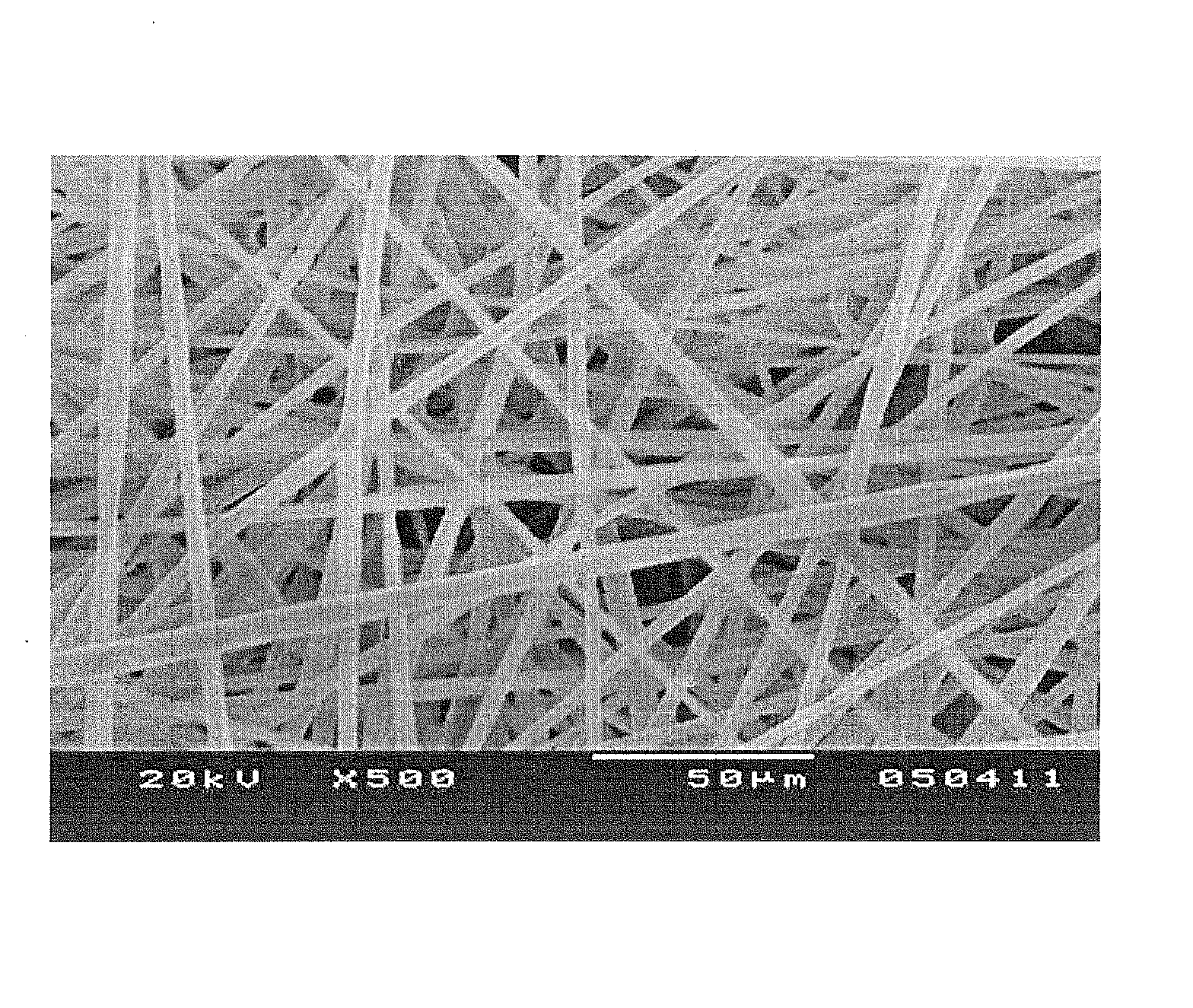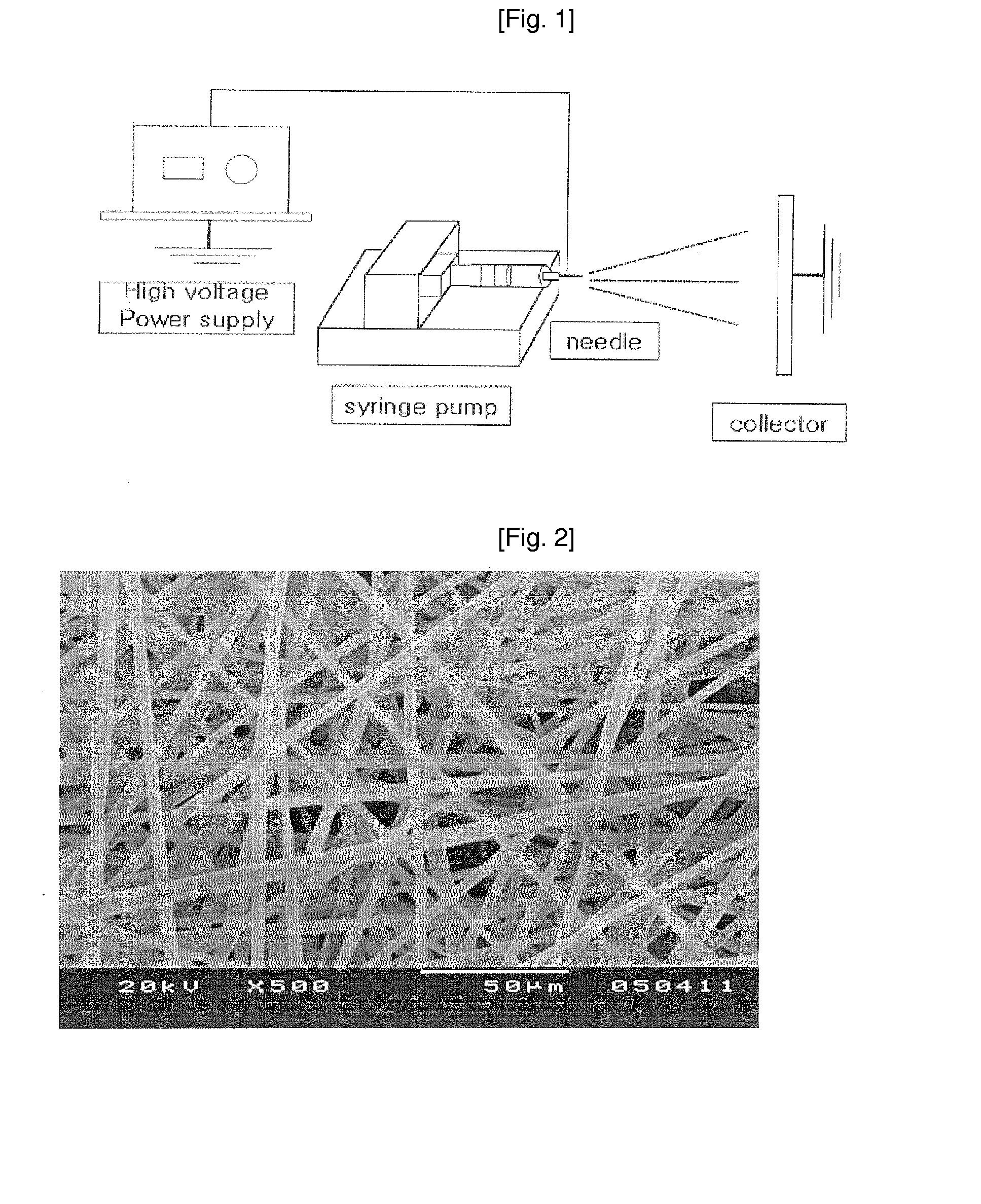Fibrous 3-Dimensional Scaffold Via Electrospinning For Tissue Regeneration and Method For Preparing the Same
a 3-dimensional, tissue regeneration technology, applied in the direction of prosthesis, application, drug composition, etc., can solve the problems of destroying or contracting the scaffold, the strength of the natural polymer is so poor, and the use of the fibrous matrix scaffold is not common
- Summary
- Abstract
- Description
- Claims
- Application Information
AI Technical Summary
Benefits of technology
Problems solved by technology
Method used
Image
Examples
example 1
Preparation of a Polymer PLLA Fiber
[0048]A PLLA polymer was dissolved in 10 < of dichloromethane solution, resulting in a 5-10% spinning solution. A fiber was prepared from the spinning solution by electrospinning (FIG. 1).
[0049]As an electro-spinner, DH High Voltage Generator (CPS-40KO3VIT, Chungpa EMT, Korea) was used and the details of the electrospinning process are illustrated with the reference to FIG. 1.
[0050]The 5-10% polymer PLLA solution (spinning solution) was filled in a spinning solution depository, which was a 10 < glass syringe. A needle with blunt tip, which is 0.5-1.2 mm in diameter, was used. The releasing speed of the spinning solution was adjusted to 0.060 ml / min. Voltage was set at 10-20 kV and the electric field distance was adjusted to 10-20 cm. It was important for the entire solvent to be volatilized before the drip of the solution on a collector to prepare a target fiber. Thus, the temperature and humidity had to be carefully regulated; the optimum temper...
example 2
Preparation of a Low Molecular PLLA Fiber
[0053]A low molecular PLLA was dissolved in 10 < of dichloromethane solution, resulting in a 14-20% spinning solution. A fiber was prepared from the spinning solution by electrospinning (FIG. 1).
[0054]As an electro-spinner, DH High Voltage Generator (CPS-40KO3VIT, Chungpa EMT, Korea) was used and the details of the electrospinning process are illustrated with the reference to FIG. 1.
[0055]The 14-20% low molecular PLLA solution (spinning solution) was filled in a spinning solution depository, which was a 10 < glass syringe. A needle, which is 0.5-1.2 mm in diameter, was used. The releasing speed of the spinning solution was adjusted to 0.060 ml / min. Voltage was set at 10-20 kV and the electric field distance was adjusted to 10-20 cm. It was important for the entire solvent to be volatilized before the drip of the solution on a collector to prepare a target fiber. Thus, the temperature and humidity had to be carefully regulated; the optimum t...
example 3
Preparation of a Spinning Solution using Dichloromethane and 1,1,1,3,3,3-hexafluoroisopropylpropanol
[0058]To dichloromethane was added 1,1,1,3,3,3-hexafluoroisopropylpropanol by 2% of the total solvent, resulting in dichloromethane solution. Then, polymer and low molecular PLLA were dissolved in the dichloromethane solution to prepare a spinning solution with proper concentrations of the polymer and low molecular PLLA. A fiber was prepared from the spinning solution by electrospinning. The resultant fiber was proved to be very stable in shape and spun at a wide range of temperature and humidity (possibly spun even at 30° C. with 50% humidity). The obtained polymer was confirmed to be 1-10 < in diameter. The addition of 1,1,1,3,3,3-hexafluoroisopropylpropanol caused the fiber to be thinner and more stable spinning, but at the same time, increased electrostatic force between fibers and formed a shield-like membrane.
PUM
| Property | Measurement | Unit |
|---|---|---|
| boiling point | aaaaa | aaaaa |
| size | aaaaa | aaaaa |
| inner diameter | aaaaa | aaaaa |
Abstract
Description
Claims
Application Information
 Login to View More
Login to View More - R&D
- Intellectual Property
- Life Sciences
- Materials
- Tech Scout
- Unparalleled Data Quality
- Higher Quality Content
- 60% Fewer Hallucinations
Browse by: Latest US Patents, China's latest patents, Technical Efficacy Thesaurus, Application Domain, Technology Topic, Popular Technical Reports.
© 2025 PatSnap. All rights reserved.Legal|Privacy policy|Modern Slavery Act Transparency Statement|Sitemap|About US| Contact US: help@patsnap.com



